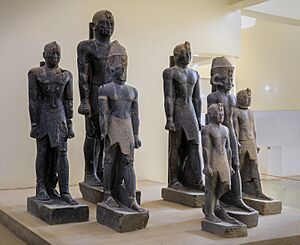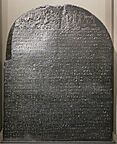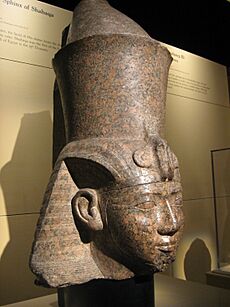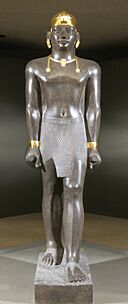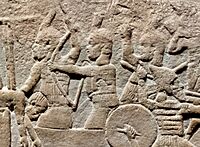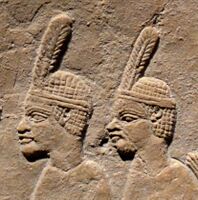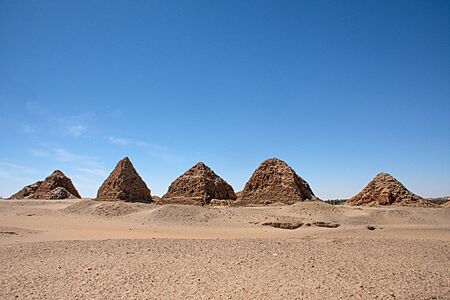Twenty-fifth Dynasty of Egypt facts for kids
Quick facts for kids
Twenty-fifth Dynasty of Egypt
|
|||||||||||||||||||||
|---|---|---|---|---|---|---|---|---|---|---|---|---|---|---|---|---|---|---|---|---|---|
| 754 BC–656 BC | |||||||||||||||||||||

Kushite heartland, and Kushite Empire of the 25th dynasty of Egypt, circa 700 BC.
|
|||||||||||||||||||||
| Capital | Napata Memphis |
||||||||||||||||||||
| Common languages | Egyptian, Meroitic | ||||||||||||||||||||
| Religion | Ancient Egyptian religion Kushite religion | ||||||||||||||||||||
| Government | Monarchy | ||||||||||||||||||||
| Pharaoh | |||||||||||||||||||||
|
• 744–712 BC
|
Piye (first) | ||||||||||||||||||||
|
• 664–656 BC
|
Tantamani (last) | ||||||||||||||||||||
| Historical era | Third Intermediate Period of Egypt | ||||||||||||||||||||
|
• Established
|
754 BC | ||||||||||||||||||||
|
• Disestablished
|
656 BC | ||||||||||||||||||||
|
|||||||||||||||||||||
The Twenty-fifth Dynasty of Egypt, also known as the Nubian Dynasty or the Black Pharaohs, was a group of rulers from the ancient Kingdom of Kush. This kingdom was located in what is now northern Sudan and southern Egypt. These pharaohs ruled parts or all of Ancient Egypt for almost 100 years, from 744 to 656 BC. Their main capital was Napata.
The rulers of the 25th Dynasty loved Egyptian culture. They used the Egyptian language and writing. They also brought back many old Egyptian religious, artistic, and literary traditions. Some experts believe the dynasty started with Egyptian priests who moved to Kush.
This dynasty brought Lower Egypt, Upper Egypt, and Kush back together. This created the largest Egyptian empire since the New Kingdom. They fit into Egyptian society by bringing back ancient religious practices, building temples, and using old art styles. They also added some unique Kushite ideas. During their rule, many pyramids were built again, especially in what is now northern Sudan. This was the first time pyramids were widely built since the Middle Kingdom.
Later, powerful kings from the Neo-Assyrian Empire defeated the Nubian rulers. This led to the Assyrian conquest of Egypt. The end of the 25th Dynasty marked the start of the Late Period of ancient Egypt. The Twenty-sixth Dynasty then took over. They were first controlled by the Assyrians but later became independent.
Contents
History of the Dynasty
Piye: The First Pharaoh
The 25th Dynasty started in Kush, which is in modern-day Northern Sudan. The city of Napata was their spiritual home. From there, Piye led an army and took control of Egypt. Piye wrote about his victory on a large stone tablet called the "Stele of Victory."
This stele announced Piye as the Pharaoh of all Egypt. It showed his divine power by calling him "Son of Re" (ruler of Lower Egypt) and "Beloved of Amun" (ruler of Upper Egypt). Piye brought back the tradition of building pyramids, which was common in the Old and Middle Kingdoms. He built the oldest known pyramid at the royal burial site of El-Kurru. He also made the Temple of Amun at Jebel Barkal much bigger.
Piye tried to expand Egyptian influence into the Near East. This area was controlled by the Neo-Assyrian Empire. In 720 BC, he sent an army to help a rebellion against Assyria in Philistia and Gaza. However, Piye's army was defeated by the Assyrian king Sargon II.
The Stele of Piye also says that Piye was very religious and loved horses. He was upset with anyone who treated horses badly. He even asked for horses as gifts and had eight of his own horses buried with him. Studies show that the best horses in Egypt and Assyria came from Nubia. These strong horses, along with chariots and new cavalry tactics, helped Piye defeat his enemies.
Shebitku and Shabaka

There has been some debate among historians about whether Shabaka or Shebitku ruled first. Newer archaeological findings suggest that Shebitku ruled before Shabaka.
According to the newer timeline, Shebitku took control of the entire Nile Valley, including Upper and Lower Egypt, around 712 BC. He even had the previous ruler, Bocchoris, burned to death for fighting against him. After conquering Lower Egypt, Shebitku moved the capital to Memphis.
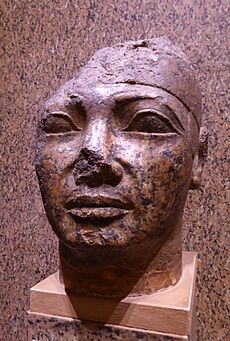
Historians believe Shebitku was king of Egypt by 707/706 BC. This is based on an inscription from the Assyrian king Sargon II. The inscription, found in Persia, calls Shebitku the king of Meluhha (a name for Nubia). It also says Shebitku sent a rebel back to Assyria in handcuffs.
After Shebitku, Shabaka became pharaoh. He moved the capital to Memphis and worked to restore many great Egyptian monuments and temples. Shabaka brought back an older style of Egyptian art and religion. He also became the first priest of Amon, making Egypt a religious monarchy again. Shabaka is also known for creating the Shabaka Stone, which has an important ancient religious text carved into it.
Taharqa: A Prosperous Reign
In 690 BC, Taharqa became pharaoh in Memphis. His rule was a very good time for the empire. The Nile River had large floods, which meant lots of crops and wine. Taharqa gave a lot of gold to the temple of Amun at Kawa. He also built and restored many great structures throughout the Nile Valley, including works at Jebel Barkal and Karnak. The city of Thebes became very rich and grand during his time. Taharqa and the Kushites brought a new life to Pharaonic art.
Taharqa built the largest pyramid in the Nubian region at Nuri. It had a very detailed rock-cut tomb. He was buried with over 1070 small statues called shabtis.
Taharqa's army had successful military campaigns. In 701 BC, Taharqa and his army helped Judah and King Hezekiah against a siege by the Assyrian King Sennacherib. There are different ideas about why the Assyrians failed to take the city and left. Many historians say that Judah had to pay tribute to Sennacherib after the siege. However, other evidence suggests that Egypt still had influence in the area.
In 674 BC, the Assyrian King Esarhaddon invaded Egypt. Taharqa and his army defeated the Assyrians in this battle. But in 671 BC, Taharqa was defeated when Esarhaddon conquered Northern Egypt, captured Memphis, and made Egypt pay tribute. In 669 BC, Taharqa took back Memphis and the Delta region. Esarhaddon again led his army to Egypt, but he died. His son, Ashurbanipal, took over command. Ashurbanipal and the Assyrians went as far south as Thebes. Taharqa then went back to Nubia, where he died in 664 BC.
Tantamani: The Last Pharaoh
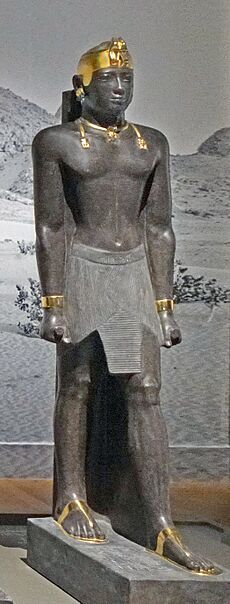
Taharqa's successor was Tantamani. He sailed north from Napata with a large army to Thebes, where he was officially made king of Egypt. From Thebes, Tantamani began to take back control of Egypt, reaching as far north as Memphis. Tantamani's "dream stele" says he brought order back to the land. After defeating Sais and killing Assyria's ally, Necho I, in Memphis, Tantamani continued north. He attacked cities in the Delta, and many of them surrendered to him.
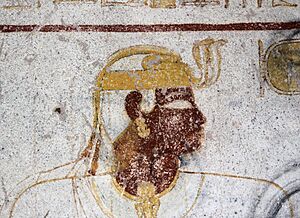
Necho's son, Psamtik I, fled to Assyria. He returned in 664 BC with Ashurbanipal and a large army. When the Assyrians arrived in Egypt, Tantamani ran to Thebes. The Assyrians followed him and sacked Thebes in 663 BC. Tantamani then escaped to Nubia.
Psamtik I was made ruler of Lower Egypt by Ashurbanipal. Psamtik quickly united Lower Egypt and drove out the Assyrian army. He became the first ruler of the Twenty-sixth Dynasty. In 656 BC, Psamtik sent a large fleet south to Thebes. He peacefully took control of Upper Egypt, uniting all of Egypt.
Tantamani and the Nubians never threatened Assyria or Egypt again. Tantamani was buried in the royal cemetery of El-Kurru. The 25th Dynasty ruled Egypt for less than 100 years. The Kushite rulers then went back to their homeland in Nubia. They continued their kingdom at Napata and later at Meroë.
Armies of the 25th Dynasty
The Nubian and Egyptian soldiers of the 25th Dynasty are shown in some Assyrian carvings. These carvings are about the Assyrian conquest of Egypt. For example, the Siege of an Egyptian fort in 667 BC shows Nubian soldiers defending their city. It also shows prisoners wearing the special one-feathered headgear of Taharqa's soldiers.
Revenge of Psamtik II
Psamtik II was the third ruler of the next dynasty, the Twenty-Sixth Dynasty. He purposely destroyed monuments made by the 25th Dynasty Kushite kings in Egypt. He erased their names and royal symbols from statues and carvings. Then, in 592 BCE, he sent an army to Nubia to remove all signs of their rule. This happened during the reign of the Kushite King Aspelta. This expedition and its destruction are written on several victory stones, especially the Victory Stela of Kalabsha. This event led the Kushite capital to move further south to Meroë.
Art and Architecture
Even though the 25th Dynasty only ruled Ancient Egypt for 91 years (747–656 BC), they are very important in Egyptian history. They brought back traditional Egyptian values, culture, art, and architecture.
The 25th Dynasty revived the old Egyptian tradition of building pyramids for their dead rulers. Nubian kings built their own pyramids 1000 years after Egyptians had stopped building them. Nubian pyramids were first built at El Kurru in 751 BC for Piye, the first ruler of the 25th Dynasty. More were built at Nuri. These Nubian pyramids were similar to a type of Egyptian family pyramid that was common during the New Kingdom. Today, there are twice as many Nubian pyramids still standing as there are Egyptian ones.
-
The pyramid of Piye, founder of the 25th Dynasty, at El-Kurru, Sudan.
-
The Shrine of Taharqa from Kawa, Ashmolean Museum
-
Taharqa making offerings to the lion-headed Mut. Temple of Mut, Jebel Barkal
Pharaohs of the 25th Dynasty
The pharaohs of the 25th Dynasty ruled Egypt for about 91 years, from 747 BC to 656 BC.
| Pharaoh | Image | Throne name | Horus-name | Reign | Pyramid | Consort(s) | Comments |
|---|---|---|---|---|---|---|---|
| Piye |  |
Usimare | Kanakhtkhaemnepet | c. 747–714 BC | Kurru 17 |
|
Kashta is sometimes seen as the first pharaoh, but Piye is usually considered the founder. |
| Shebitku | 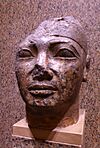 |
Djedkare | Djedkhau | 714–705 BC | Kurru 18 | Arty (Kurru 6) | |
| Shabaka | 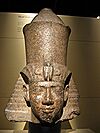 |
Neferkare | Sebaqtawy | 705–690 BC | Kurru 15 |
|
|
| Taharqa |  |
Khunefertumre | Qakhau | 690–664 BC | Nuri 1 |
|
|
| Tantamani | 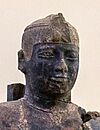 |
Bakare | Wahmerut | 664–656 BC | Kurru 16 |
|
Lost control of Upper Egypt in 656 BC when Psamtik I took Thebes. |
The period from Kashta to Malonaqen is sometimes called the Napatan Period. The later kings of the 25th Dynasty ruled over Napata, Meroë, and Egypt. The main government and royal palace were in Napata during this time. The kings and queens were buried in El-Kurru and Nuri.
Alara, an early Nubian king before Kashta, is not considered part of the 25th Dynasty because he did not control any part of Egypt. While Piye is seen as the founder, some writings might include Kashta because he already controlled parts of Upper Egypt. A stone tablet of his was found at Elephantine. Kashta also had enough power to have his daughter Amenirdis I adopted as the next Divine Adoratrice of Amun in Thebes.
Timeline of the 25th Dynasty

See also
- Aethiopia is an old Greek name for regions in Sudan and south of the Sahara desert.
- History of Ancient Egypt
- List of monarchs of Kush
- Twelfth dynasty of Egypt
- Twenty-fifth dynasty of Egypt family tree


